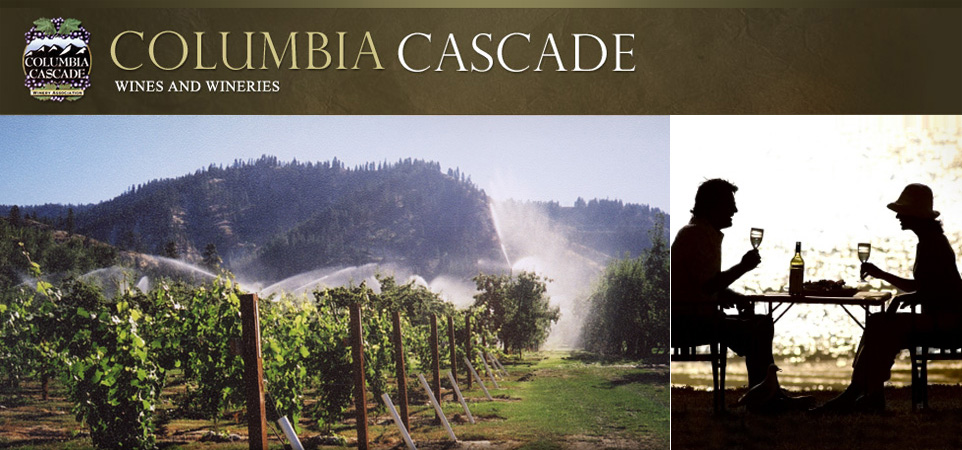
A new wine region has appeared among the rivers, lakes, and mountains of North Central Washington. You’ll travel through this region as you tour Washington’s ultimate road trip, the awe-inspiring Cascade Loop.
Bordered by the towering Cascade Mountains to the west and sagebrush covered hills to the east, vineyards and wineries are rapidly appearing throughout the area.
The winemakers of this area have joined together in the belief that the influence of the Cascade Mountains and the broad rivers and lakes makes the region unique among Washington State’s wine growing regions. In recognition of this we are calling the area the Columbia Cascade region. It is the fastest growing wine region in Washington State. Come enjoy outstanding wines, wonderful people, great weather, beautiful scenery, indoor and outdoor activities, summer theater, great dining, a wide variety of lodging facilities, entertainment, attractions, there is something in our region for everyone.
Please come join us, relax and enjoy our region, The Columbia Cascade Winery Association Region, in North Central Washington.
Columbia Cascade Wines And Wineries in the Cascade Valley and North Central Washington
- Lake Chelan Wineries and Tasting Rooms
- Leavenworth Wineries and Tasting Rooms
- Wenatchee Wineries and Tasting Rooms
- Recipes From Columbia Cascade Wines And Wineries
Education about Wines of the Columbia Cascade Wines Region
Wines of the Columbia Cascade Wines And Wineries Area
Washington State Red Wines
Cabernet Sauvignon
Perhaps the world’s most renowned grape variety for the production of fine red wine, Cabernet sauvignon is recognizable for its exact fruit aromas, often likened to blackcurrants, its structure and its ability to provide the perfect vehicle for individual vintage characteristics. It stands out for its remarkable concentration of phenolics, making it easily capable of producing deeply colored wines with a complex bouquet, worthy of long-term wood ageing.Distinguishing marks of the Cabernet Sauvignon berry include it small size, its high ratio of pip to pulp and the thickness of its distinctively blue skins. The pips are a major factor in Cabernet Sauvignon’s high tannin level, while the skins account for the depth of color, which identifies a Cabernet Sauvignon in many blind tastings. The thickness of the skins also makes the grape relatively resistant to rot.
One of Washington’s two major black grape varieties, along with the hugely successful Merlot, Cabernet’s characteristics vigor, late ripening and ease of harvest make this varietal ideally suited to North Central Washington vineyards.
Cabernet Franc
Presumed to be a mutation of Cabernet Sauvignon, Cabernet Franc is used primarily to lend a sparkling aroma of spice when blended with other varietals. With its herbaceous elements and its distinctive aroma of raspberries, Cabernet Franc is more approachable than Cabernet Sauvignon, and also lower in acids and tannins.
Well-suited to cooler inland climates, it buds and ripens considerably earlier than Cabernet Sauvignon and is somewhat less susceptible to poor weather. As a wine, Cabernet Franc tends to be lighter in color and body with more immediate fruit and earlier maturation then Cabernet Sauvignon.
Merlot
This vigorous, productive varietal yields ruby-red, full-bodied wines of great distinction, yet can be blended comfortably with a variety of other wines. Although it has fewer tannins, less acidity and a correspondingly lower durability than Cabernet Sauvignon, wines made with Merlot tend to have higher alcoholic strength, presenting a rich, fruity and malty nose.
Although risky to grow in cold climates, Merlot vines do not require quite so favorably exposed a site and tend to bud early. On the other hand, Merlot responds well to damp, cool soils and North Central Washington’s hot dry summers with well-drained soils can leave the grapes underdeveloped. Also, although its yield is generally high, Merlot produces looser bunches of larger, thinner-skinned grapes that are more prone to rot than Cabernet Sauvignon. This varietal is rarely grown in North Central Washington.
Pinot Noir
Dating back to 14th century France, Pinot Noir is one of the world’s oldest vine varieties. Although it is difficult to grow, and prefers cooler growing conditions, this varietal has found a limited place in Oregon and Washington vineyards. Also, early budding and ripening make it vulnerable to spring frost. It produces clusters of remarkably small, closely set thin-skinned grapes, which are prone to rot. As Pinot Noir is also quite low in tannins, some winemakers press this varietal with the stalks as a means of augmentation.
Aside from a slight suggestion of sweetness and its relatively high alcohol levels, Pinot Noir is a wine of modest distinguishing characteristics. The color is a medium cardinal red and the aroma generally conveys a mellow fruitiness. In France, Pinot Noir constitutes the basis of Champagne, and European Pinot Noir is often vinified into a white wine. To date, North Central Washington vintners are bottling Pinot Noir as a pure varietal, rather than using it as a blend.
Syrah
Originally brought to the Rhone Valley by traders from the ancient Persian city of Shiraz, Syrah is considered among the noblest of the black grape varieties. Esteemed for its hardiness and resistance to disease, Syrah is easier to grow than Cabernet Sauvignon, but can create wines of comparable distinction, which are capable of great longevity.
Dry, dark, dense and tannic, Syrah wines need time to show their greatness. Long, cool fermentation followed by extensive ageing in oak brings out the concentration of flavors, which are typically described as “bittersweet, smoky and spicy berry.”
Malbec
Dark in color and strong in tannins, this varietal produces a thinner, lighter-weight version of Merlot, soft and fairly low in acid. Vaguely reminiscent of blackberries when young, Malbec wine makes an interesting blending partner for Gamay, Merlot or Cabernet. With extended ageing, Malbec can become more ripe and lush.Sensitive to frost, rot and downy mildew, Malbec is not a particularly durable vine. The vine flowers are also susceptible to coulure, or failure to develop.
Whashington State White Wines
Gewurztraminer
A white grape with slightly reddish fruit, Gewurztraminer produces a pungent, aromatic golden yellow wine, often with strong alcohol content. Despite its relatively low acidity, these wines have a long life and are well-adapted to production of the sweeter, late-harvest designations.
Flourishing under cooler growing conditions, the “Traminer” grape is of German or Northern Italian origin (“Gewurz “means “spice” in German) and is notable at harvest for its variegated color. Too hot a climate can yield oily or bitter results, and the vine’s productivity can be low and uncertain. It retains popularity, however, due to its ability to produce – in good years – a deeply colored, opulently perfumed and fuller bodied white wine than almost any other vinifera.
Riesling
A late-ripening variety that delivers outstanding wines in cool growing regions, Riesling grapes have been grown successfully on many of North Central Washington’s steep, sunny slopes. The vines are demanding, rich in extracts and relatively durable. Grapes are resistant to rot, due to their thick skins, but retain a definite acidity, even if picked late.
Riesling has remained popular among white wine drinkers as it can be vinted at all levels of sweetness while keeping its characteristic flowery, steely, honeyed aromas intact. Late-harvest Riesling yields a sweeter, spicier, exuberant full-bodied wine which pairs well with fruits and desserts.
Chenin Blanc
Distinctive “off-dry” flavors of honey and damp straw with variable sweetness mark this crisp, versatile white wine. Chenin’s clean, refreshing bouquet has kept its popularity high among appreciators of greater austerity and a more acid structure. Possessed of great longevity, Chenin is also cultivated as a base for a wide range of fortified wines and spirits, such as sherry, port and brandy. Its high acidity makes it a useful base for sparkling wines as well.
Resistant to wind and disease, these vigorous grapes have a tendency to bud early and ripen late, both inconvenient attributes in cool climates.
Pinot Gris
The reddish-blue shimmer of this popular white grape attests to its descent from the Piont Noir varietal. Capable of producing soft, gently-perfumed wines with more substance and color that most whites, the sweetness levels of Piont Gris can very widely. Low in acid, with a certain spiciness of aroma, this is a wine much sought-after by drinkers of dry, full-bodied whites.
Favoring damp, cool soils and tending to yield an irregular or unpredictable crop, Pinot Gris has yet to gain popularity as a North Central Washington vineyard staple
Roussanne
Named for the delicate russet color of the grapes, Roussannes chief attribute is its refreshingly herbal aroma together with acidity, which allows it to age gracefully. It makes a fine blending partner with Marsanne and Chardonnay.
Roussanne vines have relatively irregular yield, poor wind resistance, and can suffer from drought conditions. It needs to be harvested at full maturity in order to reach its peak expression.
Semillon
A golden grape variety originating in southern France, this wine is the key ingredient in Sauternes and is often blended with its traditional partner Sauvignon Blanc. Yielding full-bodied, “fat” rather neutral wines, often lightly lemony when young, Semillon is high in alcohol but low in acidity. It responds well to oak ageing, whereupon it attains a golden, almost orange, color and a rich, waxy flavor.
The grape is thin-skinned and prone to rot, and vines need cool temperatures to attain their characteristic tart, grassy aroma. Although the vines are easy to cultivate, extra vigorous pruning is needed to prevent over-production of grape clusters, which ripen early to mid-season.
Sauvignon Blanc
Zesty, aromatic and quite drinkable when young are defining characteristics of this cool, “flinty” white wine, with its aromas of gooseberries and nettles. When blended with Semillon and matured in oak, a rich golden wine of weight and substance results, high in alcohol and very long-lived.
Grapes can be picked relatively early in the fall, although the budbreak is fairly late in the spring, factors which suit North Central Washington vineyards well.
Viognier
Viognier is one of the most exotic and rarest French white Grapes. It has a honeysuckle, litchi, melon, musk, orange blossom and peach flavor.
Additional information on Washington State wine grapes:
[A] Aubaine – Auvernat – Auvernat Noir
[B] Beaunois – Bigney – Black St. Peter – Blanc Doux – Blauburgunder – Blauer Klevner – Bordo – Bouchet – Bouchy – Breton
[C] Cabernet Franc – Cabernet Sauvignon – Carmenet – Chardonnay – Chenin Blanc – Chevrier – Chiavennasca – Columbier – Coraillod – Crabutet Noir
[E] Epinette Blanche
[F] Feinburgunder – Frühburgunder
[G] Gentil Rose Aromatique – Gewürztraminer – Green Grape – Gros Bouchet
[H] Hunter Riesling
[J] (Johannisberg) Riesling
[M] Malaga – Medoc Noir – Merlot – Morillon – Muscat – Muscat Blanc à Petit Grains – Muskat-Sylvaner
[N] Nebbiolo – Noirien
[O] Orange Muscat
[P] Petit Cabernet – Petite Sainte-Marie – Petite Vidure – Picutener – Pugnet – Pineau de la Loire – Pinot Blanco – Pinot Chardonnay – Pinot Noir – Plavac Mali – Primitivo
[R] Red Traminer – Rheinriesling – Rhine Riesling – Riesling – Riesling Renano
[S] Sauvignon Blanc – Sauvignon Gris – Sauvignon Noir – Sauvignon Jaune – Sauvignon Rose – Schwartz Klevner – Semillion – Sémillon – Shiraz – Spanna – Spätburgunder – Steen – Syrah
[T] Traminer Musque
[U] Uva Francese
[V] Veron – Vert Dore – Vidure – Vranac
[W] White Pinot – Weisser Clevner – Weisser Riesling – White Riesling
[Z] Zinfandel
Wine Variety Name
BLACK ST. PETER: Thought to be the early 19th century Californian name for the variety subsequently known as Zinfandel. (See below).
BLAUBURGUNDER: Clone of Pinot Noir widely grown in Germany and Austria. Also known as Spätburgunder in Austria.
CABERNET FRANC: Recently – (4-97) – discovered to be one of the parent grape varieties that gave rise to the Cabernet Sauvignon cultivar. Mainly found in cooler, damper climatic conditions than its offspring. Shows moderately vigorous growth and earlier wood and crop maturation than Cabernet Sauvignon. Recommended for grafting to the 3309 root in New York state where it has shown good winter hardiness. Widely grown in the Loire region where it is known as the Breton and in large areas of southwest France where it is sometimes known as Bouchy or Bouchet. Other french synonym names are Carmenet, Gros Bouchet and Veron. In N.E Italy the variety is known as the Bordo winegrape. Bordeaux wines commonly contain a blend of both Cabernet varietal wines, a practice increasingly being followed in California and elsewhere. Wine from these grapes has a deep purple color, when young, with a herbaceous aroma. Just like Cabernet Sauvignon, North American growth is mainly confined to the cooler coastal regions; Long Island (N.Y.) and the Pacific Northwest showing signs of being very hospitable. New Zealand has also proved to be a potential good home.
CABERNET SAUVIGNON: A “noble” grape famous as one of the main varieties, along with Merlot, Cabernet Franc and others used to create the magnificent french Bordeaux region blended red wines. This variety has several alias names such as Petit Cabernet, Petit Vidure and Vidure. (The latter name is the one used by those who subscribed to the now dubious theory that it was the original vine from which the cépage originated). Where grown in Italy it is sometimes referred to as the Uva Francese. Although recorded as present in the Bordeaux region since at least the 17th century, parental provenance has always been unsure. Recent research, (Meredith and Bowers, “Nature Genetics Journal” 5-97), has unexpectedly discovered that the original parents of this variety were Sauvignon Blanc and Cabernet Franc, an astounding reversal of previous assumptions. A “hard” grape, it helps make wines of classic breed, intensity and complexity that often need to bottle-age for at least 5-10 years in order to reach peak flavor condition. The most successful plantings in North America are mainly on Long Island (N.Y.) and the cooler regions of northern California. The vine is quite cold-hardy, although it acclimates slowly and can be injured by cold freezes in December and early January. In New York state the recommended rootstock graft is 3309. It has a late bud break, is relatively resistant to cracking and bunch rots, has vigorous growth and ripens in late October. In the warmer regions of California, grapes made into a single varietal wine will often produce higher than optimum levels of alcohol due to high sugar content and, conversely, lower than optimum acid levels in most years and so may tend to age less successfully than the blended french versions. Aromas and flavors include: Black-currant, blackberry, mint (etc). In the last decades of the twentieth century many other countries have seen their regions develop into prime producers – (e.g: Argentina, Chile, Italy and New Zealand).
CHARDONNAY: (aka Feinburgunder and Morillon in Austria). This variety is the best-known white wine grape grown in France and is also known as Pinot Chardonnay, an invented synonym name for the benefit of Anglo/American consumers, reportedly derived from an earlier period when the variety was mistakenly considered to be a white mutation of Pinot Noir, and still used by some in the Mâcon and Chablis regions. Other local names in the various regions of France include the aliases Aubaine, Auvernat, Beaunois, Epinette Blanche, Petite Sainte-Marie and Weisser Clevner etc. The Chardonnay vine is widely planted in the Burgundy and Chablis regions. Clone variety numbers commonly used include 76, 95, 124 and 548, plus some others, grafted to suitable calcium/lime tolerant, moderately vigorous rootstocks such as 41B or 161-49C. There, as in other cool climate regions, the wine made from it is often aged in small oak barrels to produce strong flavors and aromas. Possessing a fruity character – (e.g: Apple, lemon, citrus) – subsequent barrel-influenced flavors include “oak”, “vanilla”, and malolactic fermentation imparted “creamy- buttery” components. Hugely successful in many regions of the world due to its mid-season ripening – (late September to early October) – and versatility. Quite cold-hardy although early to bud and susceptible to bunch rots, yet retains fruit crispness in warmer growing years. Australia and New Zealand have succeeded in producing world-class wines in recent years, from selected clones of this variety, by using cold fermentation methods that result in a desired “flinty” taste in the dry versions.
CHENIN BLANC: A widely grown white-wine grape variety, known as Steen in South Africa, Pineau de la Loire in the Loire region of France and under the alias name White Pinot (Pinot Blanco) elsewhere in the world. Often made in a number of styles with or without some residual sugar. It is the favored grape of the Anjou region of France and, although naturally a hard, acidic grape slow to mature, is made into fine sweet wines that age well for a least ten years in the bottle. In the U.S. the grape all too often ends up in the generic jug wines of bulk producers as acidity enhancer for otherwise flabby high sugar/alcohol blends.
FEINBURGUNDER: Synonym name for the Chardonnay variety in Germany and the regions of Vienna and Burgenland of Austria. (See also Morillon below).
GEWÜRZTRAMINER: (“geh-verts-tram-in-er”). A clone of the parent Traminer variety. Widely grown, and one of the mainstay grapes for which the Alsace is famous, the popular Gewürztraminer produces white wines with a strong floral aroma and lychee nut like flavor. It is often regarded as somewhat similar in style to the (Johannisberg) Riesling – (below) – when vinified as slightly sweet yet tart. Occasionally it is made into a “botrytized” late harvest dessert style wine. Does well in the cooler coastal regions of Western U.S. – (where it ripens in late September) – Australia and New Zealand. In Australia the variety is also known under several alias names. Among these are Traminer Musque, Gentil Rose Aromique and Red Traminer. Cool climate growers should be aware that, in addition to quite large successful plantings of the above variety, a well-regarded cross named Traminette, developed by Cornell University in the U.S.A over the last 30 years, is currently very successfully cultivated on small commercial acreages in the Finger Lakes region of New York State and several other cool northern regions of the USA.
(JOHANNISBERG) RIESLING: (aka White Riesling in New York state (USA), Ontario and British Columbia (Canada), Riesling in Germany, Rheinriesling in Austria, Riesling Renano in Italy and Rhine Riesling in Australia). A white-wine variety widely grown along the Rhine river and tributaries – (e.g: Rheingau, Rheinhessen, Mosel, Nahe regions etc.) – in Germany and also in other cool temperate regions of Europe. It is also grown in N. America, where it can produce a flowery, fruity dry wine with high acid and low alcohol not unlike the german “Kabinett” version or a semi-dry style with some residual sugar similar to the german “Spätlese” version. If infected with appropriate amounts of “botrytis”, it can make outstanding late-harvest wines – (e.g: comparable to the german “Auslese” series). The Finger Lakes region of New York state in the U.S. and the Niagara region of Ontario, Canada produce excellent dry versions in the Mosel and Alsation styles in addition to consistent freezing temperature extracted juice made into “ice-wine”, (aka “eiswein”). Successful clones in New York include the Neustadt selected Clone 90, Clone 239 of the Moselle and Clone 356 from Geisenheim. The North-West coast of N. America seems to have the right conditions for creating the richer, earthier Rheinhessen taste in many versions, as do the cooler regions of California. Australia now produces excellent versions of the dry, crisp Alsation-style, as well as fruitier semi-sweet Mosel-type wines, as has New Zealand in recent years.
MERLOT: Classic grape widely grown in the Bordeaux region of France and elsewhere. The red wine bears a resemblance to Cabernet Sauvignon wine, with which it is sometimes blended, but is usually not so intense, with softer tannins. Matures earlier than Cabernet Sauvignon, with mid-late ripening. Moderate cold-hardiness. In California it is a popular varietal on its own and also as a percentage constituent of the red wine blend resembling Bordeaux claret called “Meritage”. It does extremely well in the state of Washington and shows great promise on Long Island, N.Y. Results in the Finger Lakes region of N.Y., where it ripens in early October, have been mixed due its relative lack of cold-hardiness and the fruit subject to bunch rots. Other countries such as Chile, Argentina and New Zealand also seem to have a suitable climate for this variety. The grape has many alias names such as Médoc Noir, Petit Merle, Vitraille, Crabutet Noir and Bigney.
MORILLON: Synonym name for the Chardonnay grape in the Austrian region of Styria. (See also Feinburgunder above).
MUSCAT: Another “cépage” family of clone varieties, making both red and white wines. Most are of the muscat type, having the unique aromatic character commonly associated with muscat wines. These include the Muscat Blanc, (a.k.a Muscadel, Moscato di Canelli), all alias names for the premier cépage varietal Muscat Blanc à Petit Grains. These clones are mostly used for making medium-sweet and dessert style table or fortified wines. An example of these is “Constantia”, a centuries-old wine blend still made in South Africa from the Orange Muscat grape, a darker skinned mutation of the Muscat Frontignan clone, (the latter also known as the Frontignac in Australia), and wine made from the Pontac, a red-wine grape translocated from south-west France. Small acreages of Orange Muscat in the Central Valley of California allow a local variation of this wine to be made by at least one producer, a situation that also occurs in Australia. Hot climate producers of sparkling wines often use the various Muscat grape clones to create wines in the style of Italian Spumante. Lesser regarded clones of the cépage include Muscat of Alexandria and others.
MUSCAT BLANC À PETIT GRAINS: (See Muscat above).
NEBBIOLO: (has synonym names of Spanna in the northern hills, Picutener and Pugnet in N.W. Piedmont and as Chiavennasca grape in Lombardy). Grape responsible for the long-lived, fine red wines of the Piedmont region of Italy. The role of honor includes traditionally vinified “Barolo”, “Gattinara”, “Barbaresco” and “Ghemme”; all huge, tannic wines that at their best can take decades to mature.
ORANGE MUSCAT: (See Muscat above).
PINEAU DE LA LOIRE: Alternate name for Chenin Blanc. (See above).
PINOT CHARDONNAY: Better known as the Chardonnay grape. (See above).
PINOT NOIR: The premier grape “cépage” of the Burgundy region of France, producing a red wine that is lighter in color than the Bordeaux reds (such as the Cabernet’s or Merlot). Cépage clones of this variety have many alias names such as Auvernat Noir, Blauer Klevner, Coraillod, Noirien, Schwartz Klevner, Vert Dore, and even plain numbers. It has proved to be a capriciously acting and difficult grape for N. American wineries, best results being obtained in cool, fog-liable regions such as the Carneros region of northern California. Choice of a suitable clone version is critical, as is careful vineyard pruning technique and planting density. The importance of clone version is amply demonstrated with the recommendation of the “Wadensville” (Wädenswil) and “Mariafelder” (Klevner Mariafeld) clones, the latter ripening in mid-October, for use in the Finger Lakes region of New York State where they has consistently produced quality wines despite not being as cold-hardy as some other clones. Oregon growers seem to have a preference for the “Pommard” clone. The worlds best “quality” wines are reputed to result from a mixing of suitable clones; a common practice in Burgundy, France, where numbers 667, 777 and 828 appear to be currently favored in addition to the reliable 114 and 115 when grafted to suitably limestone tolerant, moderately vigorous rootstocks such as Fercal and 161-49C. Cherished aromas and flavors often detected in varietal wines include cherry, mint, raspberry, truffles and the ubiquitous gamey odor in new wines often referred to as “animalé” by the french winemaker. German growers know this grape under several alias names, such as Spätburgunder (or as Frühburgunder, thought to be its mutant clone). The mutant clone variety known as Pinot Meunier is widely planted around the world under several alias names and is used to produce the main blending wine for so-called “Blanc de Noir” sparkling wines. In California the cépage has often been erroneously divided into various Gamay varieties until recent times.RIESLING: Also known as the Weisser Riesling. Premier white wine grape of Germany and Alsace, known as Rheinriesling in Austria and Riesling Renano in Northern Italy. (See (Johannisberg) Riesling above).
RHEINRIESLING: Austrian name for the Riesling grape of Germany. (See above).
RHINE RIESLING: Australian name for the Riesling grape of Germany. (See above).
SAUVIGNON BLANC: Classic white-wine variety commonly planted in the Bordeaux and eastern Loire regions of France. Shows vigorous growth and is late maturing. Members of the cépage are now thought to be descendants of the ancient Fié variety once common in the Loire region of France. The sauvignon cépage apparently derives the latter part of its name from the color of its skin. Other members include the recent – (4-97) – genetic parental link to Cabernet Sauvignon and other mutations known as the Sauvignon Noir, Sauvignon Jaune and Sauvignon Rose. The last named grape is also known as Sauvignon Gris.





